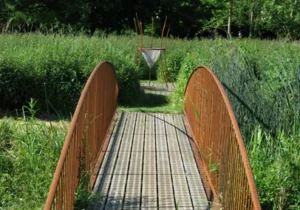Our curated Artists Takeover sees guest contributor share ideas and suggestions for reading, listening, looking, poetry, music, words and more.
The starting point for this artist take-over is the self-portrait by artist Sarah Cecllia Harrison (1863-1942) held in collections at the Hugh Lane Gallery. I became interested in Sarah Harrison because of her ‘activist’ work with Dublin Corporation and in particular her campaign for the establishment of allotments in Dublin in 1909.
The movement really took-off in 1915 due to food shortages because of the war, which drove people to grow their own food out of sheer desperation. Crossing political and religious divides, by 1919 440 acres were under cultivation.
Care and cultivation are the backbone to my practice and with that comes an interest in the politics of land use and the complex environmental issues that we currently face through climate change and how artists and activists respond to these scaled issues. If we think about the evolution of land practices and the control, use and ownership of land – we can then perhaps consider how agricultural practice – gardening being one of many extended processes in the overall agriculture machine – has directed human evolution.
-
Squatted spaces

“Everything’s coming together while everything’s falling apart: The ZAD”, 36 min., 4K, AT/DE 2017
‘Everything’s coming together while everything’s falling apart’, A 6-channel video installation by Oliver Ressler 2016-2020.
The story of ‘La Zad’ in western France began more than half a century ago, when the French government earmarked the site for a new airport as part of a plan to create a transatlantic “Great West” gateway to France and Europe. The squatters began arriving the same year, claiming they were responding to an appeal from farmers fighting compulsory purchase orders.
Since then, no airport-related construction has occurred on the 1,650-hectare site. The artist Oliver Ressler documents the people involved in this campaign through a series of recorded conversations with key members of the ZAD community, charting their struggles and the collective process of self-organisation through which they resisted the French government’s force to establish a community of cultivators.
-
Wild weeds – Gardens of resistance

In 2007, Gilles Clément designed and built ‘The Nettle Garden’ in France for the Melle Biennale in direct response to an existing law in France that forbids the use of unauthorised products – what Clement is referring to here is home-brew liquid fertilisers. A key feature of this garden is the metal sculpture designed as a filter system to make liquid plant food using nettles as the main source of ingredients, which is also the primary plant that occupies the garden. Clements considers The Nettle Garden as a statement in favor of free distribution of products proven efficient by gardeners over years of use and hence belonging to history and not to any private enterprise. It can be prepared domestically with no need for justification.
Another way of reading this space is to think about the politics of plants and how a ruderal or weed-like plant such as the NETTLE has been given star status beyond all other plants. This plant is in a permanent state of transition and flux and challenges the aesthetics of what we would plant in a garden. Clements defines his gardens as ‘Gardens of Resistance’ and has devised a manifesto – the THIRD LANDSCAPE, which regards the use of ‘leftover’ spaces and how they can be occupied to engender biodiversity.
http://www.gillesclement.com/art-453-tit-The-position-of-Melle-A-Water-Garden-A-Nettle-Garden
-
Food gardens and seed banks

Image: Christian Philipp Muller, Swiss Chard Ferry (The Russians aren’t going to make it across the Fulda anymore), 2012, Documenta 13 in Kassel, Germany
The act of seed saving is political in that it undermines the established and homogeneous seeds distributed by multinational seed companies, which limits the variety of plants that can be grown. Swiss Chard Ferry by Christian Philipp Müller.
(The Russians aren’t going to make it across the Fulda anymore) (2012) developed for Documenta 13 floated a series of planted barges with 60 different edible varieties of Swiss Chard, which he collected from various seed-banks worldwide. The project also involved the participation of visitors who were invited to taste the Swiss Chard and to explore the connections between names like “Pot of Gold” and “Pink Lipstick”, and their country of origin.
-
Soil commoning

The final example of work I present, imbues ideas around the ‘re-commoning’ of a site as a collective sustainable resource. This work developed by the collective Futurefarmers with local communities in Oslo was to create a common land dedicated to a range of activities related to art and urban food production. The work includes ‘Flatbread Societies activities’, an Allotment community, an Ancient grain field, a Bakehouse and Oslo’s first city farmer. This space is in constant organic development.
The video titled: SOIL PROCESSION + DECLARATION OF LAND USE records a procession of 50 Norwegian farmers with soil carried from their own farms from different locations across Norway to its new home in Oslo. Soil offerings were laid out upon the land in a ceremony, and in this ceremony? the site was named Lossaeter, and a declaration of land use was signed amongst all of the people involved declaring Lossaeter to be a new cultural ‘living’ institution.
-
About the Artist
Independent research-based visual artist, Christine Mackey, develops long-term projects that attend to the complexity of plant matter and local habitats, which embody notions of care and cultivation through a range of socio-environmental contexts, collaborations and media.
In 2018, she was awarded a Fulbright scholarship pursuing independent research across educational institutions and residency programmes.
Ongoing projects include ‘The Potting Shed’ (2013 -) ArtLink, Donegal, which opened a new social space inside a defunct military environment. Addressing pressing environmental issues in relation to the geopolitical control of seeds was made evident in ‘Seed Matter’ (2010-). And, devised as a series of exhibitions and a publication, ‘The Long Hedge’ (2018-) site-specific seed collection with future works currently in development, funded by the Arts Council bursary award.










